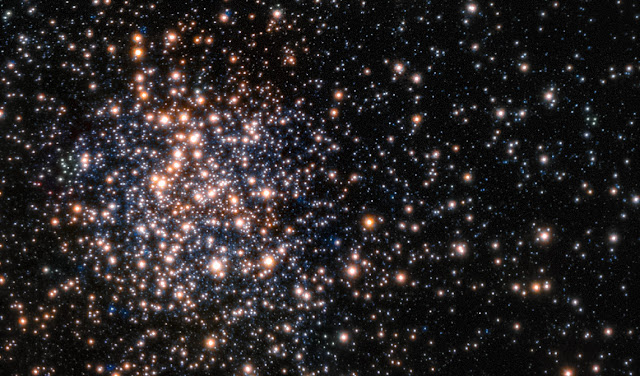The globular cluster Terzan 5, one of the oldest and most massive globular clusters in the Milky Way
Credit: ESO/F. Ferraro; CC BY 4.0
Credit: ESO/F. Ferraro; CC BY 4.0
The Milky Way, like the galaxy NGC 1300 shown here in an image from the Hubble Space Telescope, has a central bar of stars.
Credit: NASA, ESA, and The Hubble Heritage Team (STScI/AURA); Acknowledgment: P. Knezek (WIYN)
The star SOS1 is not like its neighbors. Using chemical and dynamical data, stellar sleuths have tracked this star from its current home in the Milky Way’s central bar back to its likely origin in one of the most massive globular clusters in our galaxy.
A Star in a Bar
Today, the Milky Way has an intricate and interlocking structure: thin and thick disks of stars surrounded by an extended halo, with a bulge of old stars at the center. A bar of stars cuts across the center of our galaxy, and globular clusters — ancient collections of thousands to millions of stars — dot the galactic bulge and halo. These structures didn’t always exist, and a major goal for galactic research is understanding when and how the many components of our galaxy were assembled.
One piece of the puzzle might be provided by the star 2M17454705-2639109, also known as SOS1. This star is located in the busy galactic downtown of the Milky Way’s center, orbiting within the central bar of stars. Data from the Apache Point Observatory Galactic Evolution Experiment (APOGEE) show that SOS1 has a curious chemical composition that sets it apart from its neighbors. Now, researchers have shown that these chemical differences may be evidence that SOS1 originated far from its current location — and that many other stars in the galactic bar might have completed similar journeys.
One piece of the puzzle might be provided by the star 2M17454705-2639109, also known as SOS1. This star is located in the busy galactic downtown of the Milky Way’s center, orbiting within the central bar of stars. Data from the Apache Point Observatory Galactic Evolution Experiment (APOGEE) show that SOS1 has a curious chemical composition that sets it apart from its neighbors. Now, researchers have shown that these chemical differences may be evidence that SOS1 originated far from its current location — and that many other stars in the galactic bar might have completed similar journeys.
The reddish stars of the globular cluster Liller 1 glow behind bright blue stars in the foregroun
Credit: ESA/Hubble & NASA, F. Ferraro; CC BY 4.0
Credit: ESA/Hubble & NASA, F. Ferraro; CC BY 4.0
SOS1: Far from Home?
A team led by Stefano Souza (Leibniz Institute for Astrophysics Potsdam; University of São Paolo; Max Planck Institute for Astronomy) investigated SOS1’s origins by first comparing its chemical abundance pattern to those of different populations of stars in the Milky Way. The observed pattern of low carbon, high nitrogen, and high aluminum matches expectations for second-generation stars in globular clusters: densely packed, roughly spherical collections of thousands to millions of stars.
Candidate Clusters
By Kerry Hensley
Citation
“Tracing Back a Second-Generation Star Stripped from Terzan 5 by the Galactic Bar,” Stefano O. Souza et al 2024 ApJL 977 L33.
doi:10.3847/2041-8213/ad91af
Chemical (left) and age (right) comparison between SOS1 and stars in the globular cluster Terzan 5.
Credit: Souza et al. 2024
Credit: Souza et al. 2024
But how would a star born in a globular cluster end up in the Milky Way’s central bar? Souza’s team highlighted two possible scenarios: SOS1 might have been ejected from its home cluster by a gravitational interaction with a binary star system, or — deemed more likely — it could have been stolen from its home cluster by the tidal forces of the Milky Way.
Candidate Clusters
Souza’s team used N-body simulations to determine if SOS1 once called one of the existing globular clusters home. (The team notes that it’s possible that SOS1’s parent star cluster no longer exists, having been pulled apart by the Milky Way’s powerful tidal forces.) The likeliest candidate is Terzan 5, which is among the most massive and most ancient globular clusters in the Milky Way. The simulations suggest that SOS1 might have been bound to this cluster 353 million years ago.
The chemical abundances of SOS1 support this hypothesis, since SOS1’s curious chemical makeup is consistent with that of the oldest and most metal-poor stars in the cluster. The final clue would be a comparison of the ages of Terzan 5 and SOS1. Though the data did not allow for a precise determination of the star’s age, the preliminary analysis suggests that it is of a similar age to the cluster.
The chemical similarities and dynamical properties make it likely that SOS1 once resided in a globular cluster, possibly Terzan 5. Its current residence in the Milky Way’s central bar supports the idea that ancient globular clusters contributed stars to the bar through tidal stripping.
The chemical abundances of SOS1 support this hypothesis, since SOS1’s curious chemical makeup is consistent with that of the oldest and most metal-poor stars in the cluster. The final clue would be a comparison of the ages of Terzan 5 and SOS1. Though the data did not allow for a precise determination of the star’s age, the preliminary analysis suggests that it is of a similar age to the cluster.
The chemical similarities and dynamical properties make it likely that SOS1 once resided in a globular cluster, possibly Terzan 5. Its current residence in the Milky Way’s central bar supports the idea that ancient globular clusters contributed stars to the bar through tidal stripping.
By Kerry Hensley
Citation
“Tracing Back a Second-Generation Star Stripped from Terzan 5 by the Galactic Bar,” Stefano O. Souza et al 2024 ApJL 977 L33.
doi:10.3847/2041-8213/ad91af



